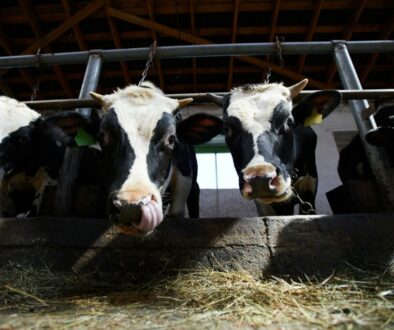Warning of food and gas price hikes, critics fight EPA rule to boost biofuels
By Anthony Lacey
With the Environmental Protection Agency (EPA) poised to finalize a rule setting annual biofuel production goals, industry players from jet fuel producers to pet food makers are warning the rule will hike already rising food and gas prices and exacerbate supply shortages.
The renewable fuel standard (RFS) rule, due to be finalized Friday under a deadline set in an April 22 consent decree, is seen by its supporters as a key step in lowering greenhouse gas (GHG) emissions and fighting climate change. Biofuels proponents say there is sufficient feedstock – renewable material which can be used or converted to use as transportation fuel, such as corn – to satisfy ambitious RFS goals while also meeting needs for non-fuel uses like food.
But critics say anticipated RFS annual production target increases will have massive and widespread negative effects on everything from grocery store prices to fuel supplies.
In a May 19 meeting with officials within the Biden administration, representatives from the American Petroleum Institute, Chevron, ExxonMobil and Shell said that prior years increases in RFS targets have not significantly increased ethanol use, and that slashing the goals is more appropriate than raising them.
“Reducing the annual volume standards is necessary to ensure near term market and program stability,” their presentation states.
The meeting came after the American Fuel & Petrochemical Manufacturers (AFPM) submitted a February 4 letter to the EPA criticizing the proposed version of the rule. The proposal “fails to adequately consider current economic conditions, fuel demand, and supply issues that are aggravated by the pandemic and affect both the achievability of the Proposal and its economic consequences,” according to the letter.
“This crisis has disrupted supply chains and affected virtually every U.S. industry. Even more recently, serious and now record inflation levels have been reached, and the Biden Administration has expressed particular concern over high fuel prices. Moreover, the Administration has initiated sales from the National Petroleum Reserve, in both 2021 and 2022, and made statements that their intent is to lower domestic gasoline prices. EPA’s Proposal ignores and contradicts these stated objectives of the Biden Administration that confirm the statutory factor of cost is a bigger and more important consideration” than the proposal suggests, the letter warned, adding, “The Proposal would only aggravate these conditions.”
Ambitious production targets
The RFS, created by Congress in 2005, is a program through which the EPA sets annual production targets for cellulosic biofuel, biomass-based diesel (BBD), advanced biofuel and total renewable fuel, which includes ethanol made from corn, along with fuels derived from other material. The program was designed to expand the U.S. renewable fuels sector, lower GHGs from transportation, and reduce dependence on imported oil.
The imminent rule will set RFS production targets for the 2022 and 2021 compliance years. Even though the 2021 fuel targets are long overdue, the agency must still publish them. The rule is also expected to lower some 2020 RFS targets, and include various technical changes to the program, such as allowing more fuels to qualify.
In its December 2021 proposed version of the rule, the EPA said it is looking to set the most ambitious biofuels production targets, also known as volumes, ever in 2022.
“For 2022, EPA is proposing the highest total volumes in history, putting the program on a stable trajectory that provides for significant growth. The proposed volumes for 2022 are over 3.5 billion gallons higher than the volume of renewable fuel used in 2020. The proposed volume of advanced biofuel for 2022 is over 1 billion gallons greater than the volume used in 2020,” the EPA said in a press release at the time.
The agency sent the final version of the rule for mandatory White House Office of Management & Budget (OMB) pre-publication review on April 29. During OMB review, which typically takes 90 days but can be much shorter in some cases, outside groups can request meetings with EPA and OMB officials to pitch their preferred outcomes of regulations. White House records show the Biden administration held at least 24 meetings on the RFS rule in May and June.
The pushback against the new standard has been heard before: Each time the EPA announces annual RFS production targets, conventional gasoline companies and their related industries push back and call for lower goals.
Potentially hinting at a litigation argument should the EPA finalize the rule as proposed, AFPM also warns that the agency’s failure to acknowledge current economic problems might be unlawful.
“EPA’s Proposal also contradicts Congress’s directive [in the Clean Air Act] to consider ‘the impact of the use of renewable fuels on the cost to consumers of transportation fuel and on the cost to transport goods,’ particularly in light of the above noted conditions,” it says. “The terms ‘inflation’ and ‘supply chain’ do not even appear in EPA’s Proposal.”
Airlines and their fuel suppliers also have concerns with the proposal, with startup LanzaJet and United Airlines among those that met with the administration on May 13 to fault parts of the rule.
Illinois-based LanzaJet, which seeks to develop “safe, sustainable fuels from waste” for use by jets and other aircraft, said at the meeting that it opposes a provision that would require ethanol to be purchased directly from producers. This would reduce purchasing flexibility by eliminating the possibility of buying from multiple suppliers, the company said. The restriction would also likely increase costs for LanzaJet, creating significant financial risks.
The overall financial impact to LanzaJet of the proposed RFS could be about $45 million over 10 years, it said, or annual costs of more than $5 million in capital expenditures and more than $4 million in operating expenses.
Food price concerns
Major food companies and retail groups met with EPA and OMB in mid-May to warn about the RFS’ potentially harmful impacts on food prices and supplies. They warn that increasing U.S. targets for biofuels production will require greater use of feedstocks like vegetable oil or corn, and that the reduced demand is likely to further increase prices and costs to the industry.
The briefing materials that they submitted highlight concerns about shortages of vegetable oil and other vital food ingredients due to the war in Ukraine and rising prices. The materials include stories from the Washington Post, New York Times and others quoting U.S. food producers as saying the price for vegetable oil, for example, is soaring past food inflation.
Representatives from The Kraft Heinz Company, Campbell’s, Kellogg’s, the American Bakers Association (ABA), American Frozen Food Institute and National Retail Federation (NRF), among other organizations, met with the administration on May 12 to outline these concerns.
NRF separately met with EPA and OMB officials on May 19 to reiterate the supply and price fears, while ABA and bakers including Bimbo Bakeries USA, Flowers Foods, Martin’s Famous Pastry Shoppe and Schwebel’s Bakery had a similar meeting on May 12.
And it’s not just the effect on food prices for humans that is concerning some groups. The Pet Food Institute held a May 26 meeting with OMB and EPA officials to warn that the pet food industry – worth $51 billion in dog and cat food sales alone last year – will face increased ingredient costs that will risk more supply shortages following any expansion of the RFS.
In particular, the group opposes the possibility of the EPA approving canola oil, a type of vegetable oil made from rapeseed, as a feedstock for producing fuels that qualify for the RFS. They say this will divert much-needed canola oil that is used in pet food production.
“At a time when the world is facing increasing food price inflation and food insecurity, now is not the time for the United States to add another type of vegetable oil to the Renewable Fuel Standard to increase our country’s renewable diesel production,” the group said in a May 18 letter to EPA’s Regan, also submitted to the meeting. “[A]dding canola oil as a pathway to renewable diesel will only exacerbate the problem of limited feedstock availability and further drive-up prices for human and animal foods. There simply is not enough current feedstock production to fulfill both fuel and food demands.”
Support for biofuels
Biofuels proponents also met with the administration about the RFS rule. In a May 23 meeting with EPA and OMB officials, representatives from the National Corn Growers Association (NCGA) pushed back on claims that biofuels production hikes food prices and harms the environment, saying neither claim has any factual basis.
A one-page summary of a recent poll by Morning Consult on NCGA’s behalf, provided at the meeting, says 43 percent of adults surveyed blame inflation for soaring food prices, 24 percent said crude oil prices are the culprit, 18 said oil supply constraints, 10 percent had no opinion, 3 percent said none of these were to blame, and just 2 percent said biofuels.
“Consumers understand the facts – that high oil prices increase both fuel and food prices,” said NCGA President and Iowa farmer Chris Edgington about the summary. “Biofuels like ethanol are the low-cost components of each fuel gallon, and ethanol adds billions of gallons to our fuel supply every year, stretching the supply to reduce our reliance on oil.”
NCGA also submitted a critical analysis of a study touted by environmentalist opponents of ethanol. Not all environmentalists support ethanol, and some advocacy groups claim production of the fuel increases GHG emissions. The study found GHGs associated with ethanol are 24 percent higher than conventional gasoline, but the NGA analysis says this finding is flawed. “[W]e conclude that the results and conclusions provided by the authors are based on several questionable assumptions and a simple modeling approach that has resulted in overestimation of the GHG emissions of corn ethanol,” the analysis says.
NGCA was also among seven other pro-biofuels groups, including the Renewable Fuels Association and Fuels America, that met with the administration on May 18. They highlighted slides from University of California, Riverside, researchers that found 15-percent ethanol reduces some emissions like carbon and particulate matter by “statistically significant” amounts compared to fuel that contains just 10 percent ethanol.
The Advanced Biofuels Association, in a May 24 meeting with EPA and OMB officials, reiterated its goal of the U.S. reaching 21 billion gallons of BBD to replace fossil fuels by 2040. The group touted the findings of research it commissioned that predicts sufficient feedstock, like soy, for making BBD, even after satisfying food and other uses.
In its May 18 meeting with the administration, the Coalition for Renewable Gas Natural Gas argued in favor of greater use of renewable natural gas (RNG), one of the fuels that qualifies for the RFS. RNG is fueled with biomethane collected from wastewater treatment plants, landfills, commercial food waste facilities, and agricultural digesters. Its supporters say making and using RNG creates massive reductions greenhouse gases compared to gasoline.
The group claimed that RNG use for transportation fuel grew 13 percent last year compared to 2020, offsetting 3.8 million tons of carbon dioxide-equivalent emissions.
Other groups and companies that met with EPA and OMB officials in recent weeks about the RFS rule include United Steelworkers, PFB Energy, the National Air Transport Association, Marathon Petroleum, the Society of Independent Gasoline Marketers of America, Clean Fuels Alliance America, House lawmakers, Delek US, Alder Fuels, and Prometheus Fuels, pro-ethanol organization Growth Energy, U.S. truck stop and travel center association NATSO, World Energy and the Brazilian Sugarcane Industry Association.




